Architectural competitions have evolved beyond being mere professional practices or educational exercises; they are now recognized as an important field of scholarly research. This book documents this shift, showcasing the value of architectural competitions for understanding professional practice and educational frameworks, as well as their implications on societal change. It discusses the historical context, growing academic interest, and the complexities of competition processes, emphasizing the importance of visual communication and knowledge production in architecture.
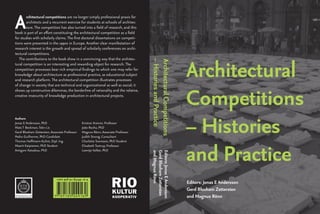


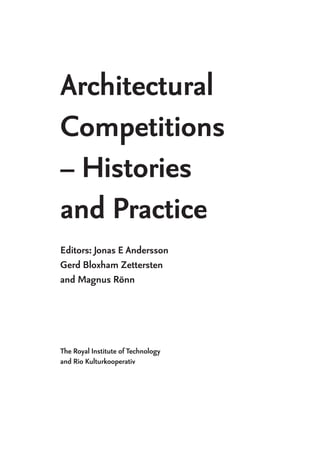


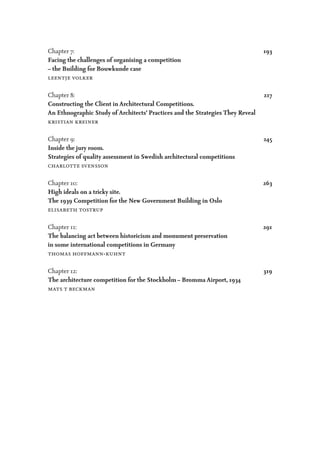




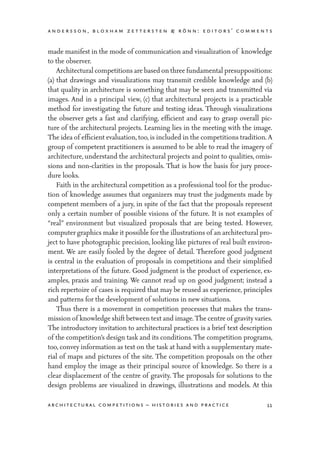


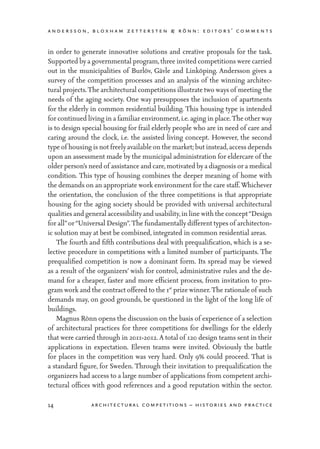
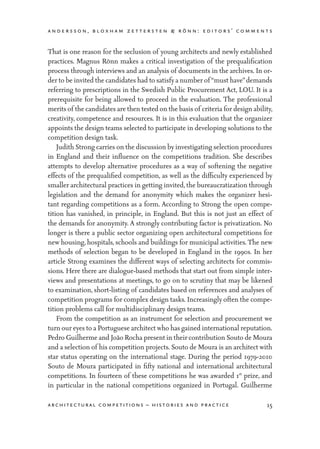



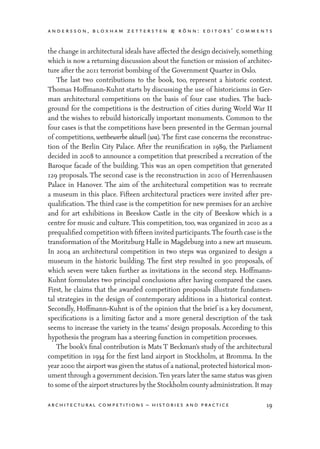
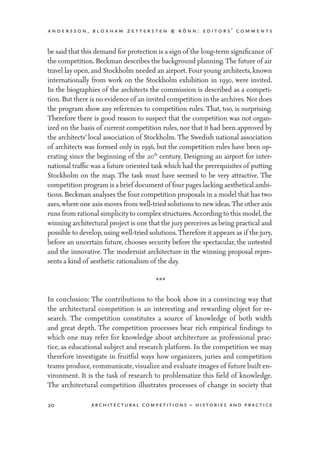
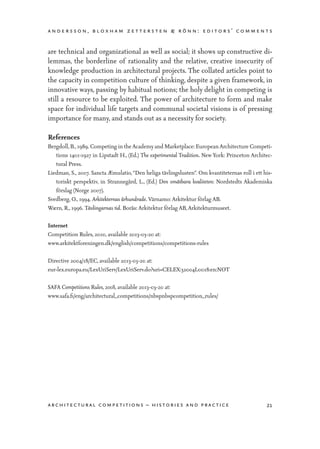

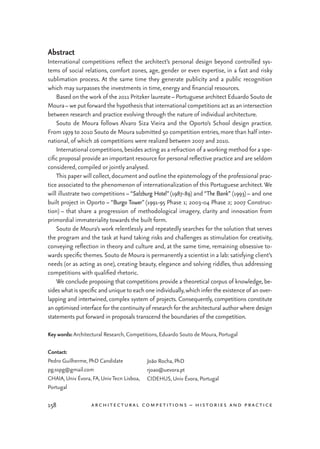

![pedro guilherme & joão rocha: architectural competitions as a lab
160 architectural competitions – histories and practice
investigation and practice by the use of competitions. We briefly identify some
types of mechanism that may lead to knowledge during the architectural design
(Alexander, 1965, 1971; Darke, 1978; Attoe, 1978; Lawson, 2001, 2004, 2005; Hill,
1998, 2003, 2006; Till, 2005a; b, 2009, 2011) and introduce the “reflection-in-action”
(Schön,2003,first edition 1983) as expressive“knowing”and part of the“lab”pro-
cess. The literature review is used to put the case studies in a research context
(Lipstadt, 1989a, 2006; Nasar, 2006; Strong, 1996; Tostrup, 1999, 2010).
Finally, the paper summarises the outcome of our investigation and formu-
lates possible conclusions and some doubts to be answered.
theorethical frame of reference
The Internationalization of Portuguese Architecture
From 1960 onward portuguese foreign policy gradually renouced the overseas
territories (Angola, Mozambique, São Tomé and Príncipe, Portuguese Guinea
and Portuguese Timor) and changes focus towards the European market, gain-
ing exterior visibility and interest. Nuno Portas1
(1934-) participates in the ar-
chitectural “Small Congresses” in Spain organized by Oriol Bohigas (1925-) in
Tarragona in 1967 and in the following year he brings Álvaro Siza Vieira (1933-)
to Victoria’s Small Congress. This becomes the initial moment for the interna-
tional recognition of Portuguese architecture.
Together, Siza Vieira (deeply influenced by Alvar Aalto architecture2
) and
his work, the intellectual and political activity of Nuno Portas and the interest
1 Nuno Portas, architect, researcher, teacher, politician and critic, was since 1957 editor at the
Portuguese magazine “Arquitectura”. In 1974, he assumed the position as Secretary of State for
Housing and Town Planning, a post he held through the first three Interim Governments. He
promoted the creation of housing cooperatives and of local support offices (GAT), created the
SAAL and started the processes leading to the adoption of the Municipal Master Plans.
2 In 1949 Siza begins his training at the School of Fine Arts (later FAUP). In 1950 Carlos Ramos
arrives to the school with an envisioned “reform in teaching architecture (…) and a major change in
the level of information (…) a certain openness (…)”(Conversation between Álvaro Siza and Eduardo
Souto de Moura, 2011, p.53). A young teacher Fernando Távora opens up to travelling and to maga-
zines:“Firstitwas Corbu[sier]. Buttimes were changing and things started coming from abroad. New
publications gave notice of what was going on,where,how and by whom. (…)Távora appeared,with a
sparkle in his eyes and a book in his hand:“Brasil builds. (…) Other magazines suddenly disappeared
(monographs of Gropius,Neutra,Mandelson,Mies) they were mysteriously substituted. (…) later our
eyes opened to marvellous architectures,arriving from all four corners of the world. Merged one after
another in turmoil, mixing, resting in the subconscient, waiting.”(Siza and Morais, 2009, p.371). This
opening was only possible then and as English magazines became available, then Italian and later](https://image.slidesharecdn.com/architecturalcompetition-201121143200/85/Architectural-competition-26-320.jpg)
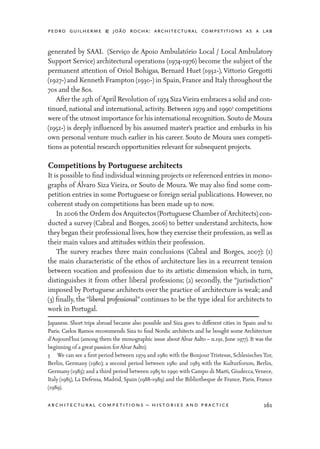
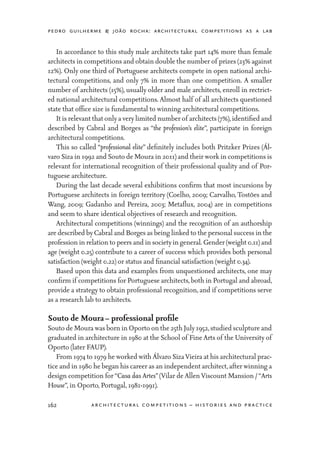
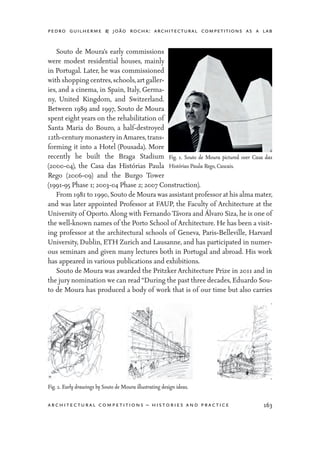

![pedro guilherme & joão rocha: architectural competitions as a lab
165architectural competitions – histories and practice
atthe FAUP and later published (Barata,Campos and Oliveira,2011).This exhibi-
tion illustrates the international recognition of Souto de Moura and establishes
an initial inventory of his competitions both in Portugal and abroad.
From 1979 to 2010 Souto de Moura participated in 50 competitions. He ob-
tained relevant positions (1st and 2nd prizes) in 16 competitions. 26 competi-
tions were completed between 2007 and 2010. Some relevant statistical infor-
mation is presented in table 1.
The first conclusion we may draw is the growing importance of competi-
tions to guarantee a commission4
in the last 5 years.
From the exhibition data we may conclude that most competitions deal with
significant urban buildings (cultural, health, sports and religious programs
make up 31 out of 50 competitions) or directly related to urban developments (7
out of 50) and only a few (4 out of 50) deal with the housing theme, half of which
are hotel programs.
Souto de Moura has a low rate of successful competitions (32% of all compe-
titions obtain the first or second prizes), and he is, statistically, more successful
in Portugal (he won 11 out of 24 competitions) than abroad (3 out of 26 competi-
tions). As Souto de Moura says“50% of all [my] designs are never built. So many
buildings are not built … today alone I lost two tenders! Two!”(Rangel, Martins,
Sá and Faria, 2009b, p.91)
Competitions are either won or lost,and even if Souto de Moura wins it does
not mean that the project will be built. There are bureaucratic, economic and
4 Yet, with the date collected, it is unclear the true economic relevance of competitions over
direct acquisition of architectural services.
Table 1 - Competition Statistics from Exhibition “Competitions 1979-2010”.
Data (Barata, Campos and Oliveira, 2011) # %
Number of competitions between 1979 and 2010 50 100%
Number of national competitions 24 48% (24/50)
Number of international competitions 26 52% (26/50)
Number of international competitions – Europe 24 92% (24/26)
Number of international competitions – Non Europe 2 8% (2/26)
Prized competitions (first and second places) 16 32% (16/50
Winning (1st place) competitions in Portugal 11 46% (11/24)
Winning (1st place) competitions abroad (international) 3 12% (3/26)](https://image.slidesharecdn.com/architecturalcompetition-201121143200/85/Architectural-competition-31-320.jpg)
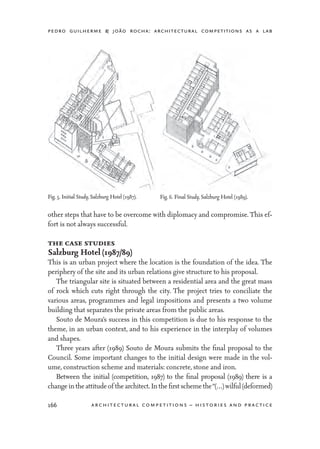



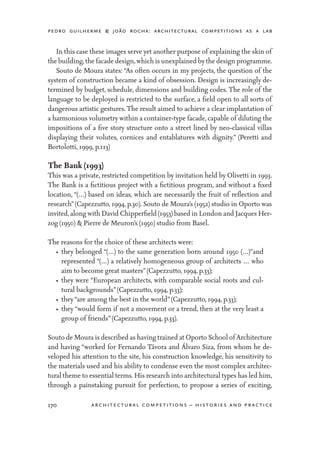



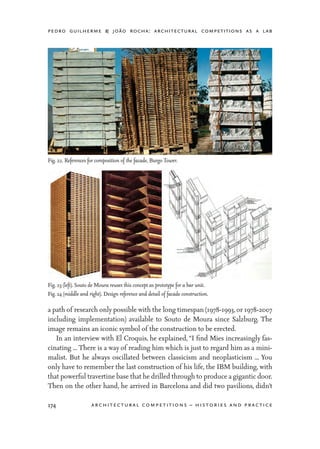




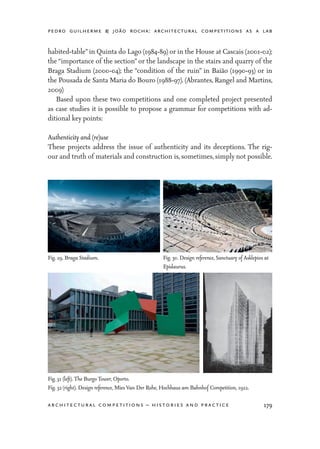


![pedro guilherme & joão rocha: architectural competitions as a lab
182 architectural competitions – histories and practice
In fact, architecture, not like other exact disciplines, is not simply the exact
result of a specific deductive method, but rather a product of a “reflection-in-
action”. As Schön believes “competent practitioners usually know more than
they can say. They exhibit a kind of knowing-in-practice, most of which is tacit
(…) [they] often revel [in] a capacity for reflection on their intuitive knowing in
the midst of action and sometimes use this capacity to cope with the unique,
uncertain, and conflicted situations of practice”(Schön, 2003, pp.viii, ix).
This “knowing” is composed of a systematic knowledge of architecture, al-
though highly professionalized due to its specialized field of expertise, firmly
bounded, scientific and standardized corpus (Schön, 2003, p.23) although in-
creasingly entangled within a broad spectrum of other competences. Bounda-
ries among architectures are continuingly shifting (Hill, 2003, 2006) and even
between architects clearly identified with the same school (like Souto de Moura
is identified with the Oporto School) there are many variations (either subtle or
fundamental) in the exercise of the profession.
As Heylighen and Neuckermans (2000) state “Architects’ greatest impact
therefore comes during the early stages of the design process, when they must
come up with one or a few ideas, powerful enough to encompass the differ-
ent aspects. These ideas are known to architects by many names, (…) but most
often are called the ‘parti’ or ‘concept’ [Lawson, 1994]. Such a concept does not
necessarily require the addition of an extra ingredient. In fact,every component
already present in the design situation, e.g. a special feature of the site or a curi-
ous trait of the client,may qualify for this focal role. Moreover,underlying ideas
are rarely found in the singular.”
Butitis undeniable,as Schön (2003) shows,thatthere is a reflection in practice
that, following a systematic approach by means of scientific method, constructs
theories based in “deliberate and idiosyncratic constructions (…) [continuingly]
put to test” (Schön, 2003, p.59). This reflection is obviously personal and based
upon the individual (repetitive) experiments and is as varied as the opportunities
to reflect.
One may think over the norms of judgments, the strategies or theories of
some pattern of behaviour or situation, or upon the divergences of practice.
These occurrences may be unique or unstable and serve as a critique to the
initial understanding of the problem, serving to construct a new description
and providing the opportunity to renew experimentation and testing. Addi-
tionally, these occurrences may constitute an appreciation, which can serve to](https://image.slidesharecdn.com/architecturalcompetition-201121143200/85/Architectural-competition-48-320.jpg)
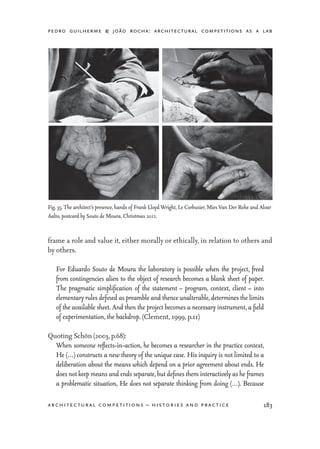

![pedro guilherme & joão rocha: architectural competitions as a lab
185architectural competitions – histories and practice
further public participation and an overall improvement of the built environ-
ment. They further represent:
Vehicles for the release of creativity, vitality, new talent and new ideas (…) creat-
ing opportunities for renewal and change in the built environment. Competitions
open way to the art of architecture and creative freedom, though within a set of
rules and programmes, and through disciplined and expert procedures. (Strong,
1996, p.29)
Each participant in a competition– sponsor,client,competitor,architect,jury and
the public – has his own definition of the cultural and symbolic qualities of the
building type, site and design and has, to some degree, a fair expectation of the
innovative architectural design (which may or may not prove to be successful).
There seem to be two major interests, sometimes opposed, at stake in a
competition. The first is the client (public or private promoter) to whom com-
petitions offer the opportunity of multiple choices in design solutions, pro-
vide awareness and public opinion (although controversy may arise), permit to
gather prestige and recognizance for its patronage, or to obtain the best quality
design possible within the available budget. The jury serves (or ought to serve)
the interests of the client.The second is the competitor– architect– who wishes
to win a commission (although it is clear that competitions consume an inor-
dinate amount of time, money and effort with no guarantee of return) since it
should provide an equitable access to the market (even to young architects), to
obtain, provide or increase status (within the class of architects) or, in business
terms, to bind the client to a design proposal, often in that connection insuring
the desired freedom for the author’s creativity, and may provide an opportunity
to explore new themes and extend areas of expertise.
In fact “it may provide a firm [or an architect] with the opportunity to think
about ideas it would otherwise not explore on a day-to-day basis” (Collyer and
Berk, 2004, p.13).
Both national and international competitions reflect the architect’s personal
design beyond controlled systems of social relations,comfort zones,age,gender
or even expertise, in a fast risky sublimation process. “In general, competitions
can bring out the best in people” (Nasar, 2006, p.23) and generate publicity and
a public recognition which may surpass the investments in time, energy and
financial resources.](https://image.slidesharecdn.com/architecturalcompetition-201121143200/85/Architectural-competition-51-320.jpg)
![pedro guilherme & joão rocha: architectural competitions as a lab
186 architectural competitions – histories and practice
International competitions assume a stronger and unconstrained position
that can help in focusing the concept and the discourse whilst assuming the
distance and the reference to the site (locus).
Many architects are aware of pitfalls they may face when entering a competition in
their own country and calculate their chances accordingly. Whereas competitions
in Europe, which are administered either under the auspices of the national asso-
ciations or on a non-regional basis according to EU rules, are relatively transpar-
ent (…) (Collyer and Berk, 2004, p.12).
Eduardo Souto de Moura provides testimony to an insight of how competitions
lead to experimentation in design and investigation in architecture, proving
that it is relevant for his own on-going work.
conclusion
In the two recent exhibitions of Souto de Moura’s work, following the 2011
Pritzker Prize, the first focusing on competitions (Barata, Campos and Oliveira,
2011) and the second focusing on his personal imagery atlas (Bandeira and Ta-
vares, 2011), it is clear that his work knowledge embraces a varied experience (“O
que aprendi com a arquitectura?”: Eduardo Souto de Moura, 2009), far beyond
the usual rigid limits of architecture– humanistic and cultural. All flow of mul-
tidisciplinary and artistic information is channelled towards the architectonic
thought either as product or as cultural production.
The competition project, with its drawings, texts and images, constitute the
end of research. Schön (2003, p.81), quoting Quist, makes references to “draw-
ing and talking [as being] parallel ways of designing and together make up what
Fig. 36. Pages from the Eduardo Souto de Moura’s Wall Atlas.](https://image.slidesharecdn.com/architecturalcompetition-201121143200/85/Architectural-competition-52-320.jpg)
![pedro guilherme & joão rocha: architectural competitions as a lab
187architectural competitions – histories and practice
[he] calls the ‘language of designing’”. These verbal and non-verbal dimensions
are closely connected.Taking into considerationTostrup’s research (2001) we can
clearly identify drawing (both present in Souto de Moura and Álvaro Siza) as
visual rhetoric, which, in conjunction with other means of communicating the
idea (verbal rhetoric),tend to shape the argumentation of reflective action. Quot-
ing Souto de Moura “drawing is a research” (Santillán and Sargiotti, 2008) and
quoting Álvaro Siza,Souto de Moura recalls“drawing is researching for lucidity”.
(ibidem)
Although “artistic ways of coping with these phenomena [uncertainty,
uniqueness, instability and value conflict] do not qualify, for them [positivists],
as rigorous professional knowledge” (Schön, 2003, p.42), it is clear from the ex-
amples presented here that, on specific occasions, the project, most frequently
in competitions, assumes the condition of scientific research or “reflection-in-
action”.
Angelillo confirms that in “small works, installations and interiors, furni-
ture design thus becomes experimental laboratories for the study of structure
and space.” (Angelillo, 1996, p.21) And Marie Clement concludes,“We need only
think of the project for the Salzburg Hotel to imagine a paradigm of this sys-
tem.The passage from the first project,an attempt to articulate the conservative
city and an interpretation of its orography,to a plan simply designed by the nec-
essary program, makes the building available, ready to establish the ‘container
type facade’8
, as with the University of Aveiro, the Olivetti contest or the Burgo
Tower.This obsessive concern in a triangular quest which weavers between dis-
cipline, language, and construction, establishing within the succession of these
projects, the principle of a ‘contamination’, expressed without false modesty in
the ‘blue notebook’9
. Each one of these projects, a complete fragment, takes on
the preceding events and already contains within itself the embryo of the fol-
lowing one. Contaminated and contaminant.”(Clement, 1999, p.11,13)
The one million dollar question would be if this “contamination” could be
possible without competitions?
I can only assume it could. We cannot deny seeing research in other Souto
de Moura’s work. It is clear that during the time he worked with Álvaro Siza at
SAAL (1974-1976) he gathered experience and did research on dwelling that was
used to further develop his personal commitment to the habited box, which
8 That erases the stories, therefore the very principal visual element of a building’s height.
9 From Aldo Rossi,“Il mio libro azzurro”, 1960.](https://image.slidesharecdn.com/architecturalcompetition-201121143200/85/Architectural-competition-53-320.jpg)
![pedro guilherme & joão rocha: architectural competitions as a lab
188 architectural competitions – histories and practice
he developed obsessively in his following single-family houses. Angelillo (1996,
p.19) confirms this view stating “Domestic architecture has always been an im-
portant field of experimentation for the architects of Oporto”.
However, it is also quite clear that he chooses competitions as prime envi-
ronments for experiments and investigations. It is apparent that it is within
competitions that Souto de Moura addresses questions most intimate to his
“course” and “discourse”. Competitions therefore seem to be the optimal place
for him to innovate and to deal with all that cannot be dealt with on a daily basis.
Acknowledgments
To Eduardo Souto de Moura and his office (Joana Correa) for all support given to this research
and all graphic material provided.
To Centre for Art History and Artistic Research (CHAIA, Univ Évora, Portugal) and Faculdade
de Arquitectura (FA, UnivTecn Lisboa, Portugal) for all support.
This Ph.D research was funded by POPH – QREN Portugal 2007-2013 (4.1 Typology – Ad-
vanced Education) and by the national budget– MCTES (SFRH / BD / 45345 / 2008).
To my supervisors, João Rocha and José Callado, to the Centre for Art History and Artistic
Research (CHAIA, Univ Évora, Portugal) and Faculdade de Arquitectura (FA, Univ Tecn Lisboa,
Portugal) for all support.
References
Abrantes,V., Rangel, B. and Martins, J.P.P., 2009. Edifício Burgo: o projecto, a obra, as tecnologias. Cad-
ernos d’Obra. Porto: GEQUALTEC.
Afonso,S.L.,Siza,Á. and Moura,E. de S.,1998. Pavilhão de Portugal. Citações e desenhos de Álvaro Siza
e Eduardo Souto de Moura. [online] Lisboa: Cimpor. Available at:
<http://cvc.instituto-camoes.pt/conhecer/biblioteca-digital-camoes/doc_download/1520-alva-
ro-siza-e-eduardo-souto-de-moura-pavilhao-de-portugal.html>.
Alexander, C., 1965. A City is not a Tree. Architectural Forum, [online] pp.122(1):58–61, 122(2):58–61.
Available at: <http://www.rudi.net/node/317>.
Alexander, C., 1971. Notes on the synthesis of form. Cambridge, MA: Harvard University Press.
Alexander, C., 1979. The timeless way of building. NewYork: Oxford University Press.
Angelillo, A., 1996. Obras de Souto de Moura. Uma interpretação. In: Eduardo Souto de Moura.
Lisboa: Blau, pp. 9–26.
Anon, 1998. Euardo Souto de Moura : obra reciente : recent work. Barcelona: GG Editorial Gustavo
Gili.
Anon, 2004. Metaflux. Porto: Livraria Civilização Editora.
Anon, 2011. Conversation between Álvaro Siza and Eduardo Souto de Moura. Casabella, 75(800),
Apr., pp. 52–65.](https://image.slidesharecdn.com/architecturalcompetition-201121143200/85/Architectural-competition-54-320.jpg)
![pedro guilherme & joão rocha: architectural competitions as a lab
189architectural competitions – histories and practice
Anon, 2011. Key projects by Eduardo Souto de Moura. Dezeen Magazine. Available at: <http://www.
dezeen.com/2011/03/29/key-projects-by-eduardo-souto-de-moura/> [Accessed 1 Aug. 2012].
Anon, 2011. Media Kit: announcing the 2011 Pritzker Architecture Prize Laureate. Available at:
<http://www.pritzkerprize.com/sites/default/files/file_fields/field_files_
inline/2011mediakittxt_0.pdf> [Accessed 10 Aug. 2012].
Attoe,W., 1978. Architecture and critical imagination. Chichester; NewYork: Wiley.
Bandeira, P. and Tavares,A., 2011. Eduardo Souto de Moura: atlas de parede: imagens de método. Porto:
Dafne.
Barata, F., Campos, A. and Oliveira, P.G. (Eds.)., 2011. Eduardo Souto de Moura : concursos = competi-
tions : 1979-2010. Porto: Faculdade de Arquitectura da Universidade do Porto.
Cabral, M.V. and Borges, V., 2006. Relatório da Profissão: Arquitecto/a. [online] Ordem dos Arqui-
tectos. Available at:
<http://www.architects.pt/documentos/1164322770I3pQH2qr9Wg02JR3.pdf.>.
Cabral, M.V. and Borges,V.,2007. Architecture asVocation and Profession: A Survey of Portuguese Archi-
tects. 8th Conference of the European SociologicalAssociation: Conflict,Citizenship and Civil
Society. Glasgow, Scotland.
Capezzutto, R. ed., 1994. The Bank. Three Architectural Concepts for the Future. Olivetti Progetti. Ol-
ivetti. [Ed.: Rita Capezzuto].
Carvalho, R.,Tostões, A. and Wang,W., 2009. Arquitectura, Portugal fora de Portugal. Lisbon, Berlin:
Aedes.
Clement, M., 1999. Vouns ne saurez rien. In: Eduardo Souto de Moura : Themes for projects. Milano:
Skira.
Coelho,A.P.,2009. Portugueses de Berlim à Mongólia. Jornal Público,[online] 8 Mar.,pp.6–7.Avail-
able at: <http://arquitectos.pt/index.htm?no=2020491578,156> [Accessed 21 Jul. 2010].
Collyer, G.S. and Berk, M., 2004. Competing globally in architecture competitions. Chichester, West
Sussex, England; Hoboken, NJ: Wiley-Academy.
Darke, J., 1978. The Primary Generator and the Design Process. Design Studies, 1(1), pp. 36–44.
Friedman, K., 1997. Design science and design education. In: The challenge of complexity : based on
the proceedings from the 3rd International Conference on Design Management. [online] Helsinki:
University of Art and Design, Helsinki UIAH, pp. 54–72. Available at:
<http://researchbank.swinburne.edu.au/vital/access/manager/Repository/swin:21128>.
Friedman, K., 2003. Theory construction in design research: criteria: approaches, and methods.
Design Studies, [online] 24(6), Nov., pp. 507–522. Available at:
<http://design.osu.edu/carlson/id785/friedman.pdf>.
Gadanho, P. and Pereira, L.T., 2003. Influx. Porto: Civilização.
Gil, J., 2008. Portugal, hoje. Lisboa: Relógio D’Agua.
Heylighen, A. and Neuckermans, H., 2000. Design(ing) knowledge in architecture. [online] EAAE/
ARCC Conference. Paris. Available at:
<https://lirias.kuleuven.be/bitstream/123456789/75850/1/00EAAEARCC.pdf>.](https://image.slidesharecdn.com/architecturalcompetition-201121143200/85/Architectural-competition-55-320.jpg)
![pedro guilherme & joão rocha: architectural competitions as a lab
190 architectural competitions – histories and practice
Hill, J., 1998. Occupying architecture. London; NewYork: Routledge.
Hill, J., 2003. Actions of architecture. London; NewYork, NY: Routledge.
Hill, J., 2006. Immaterial architecture. London; NewYork: Routledge.
Lawson,B.,2001. The language of space. Oxford; Boston:Architectural Press.
Lawson,B.,2004.Whatdesignersknow.Oxford[England];Burlington,MA:Elsevier/ArchitecturalPress.
Lawson,B.,2005. How designers think : demystifying the design process. Oxford:Architectural Press.
Lipstadt, H., 1989a. The Experimental tradition. In: The Experimental tradition : essays on competi-
tions in architecture. NewYork, N.Y: Princeton Architectural Press, pp. 9–19.
Lipstadt, H. ed., 1989b. The Experimental tradition : essays on competitions in architecture. New York,
N.Y.: Princeton Architectural Press.
Lipstadt,H.,2006.The Competition in the Region’s Past,the Region in the Competition’s Future.
In: Politics of design : competitions for public projects. Princeton: Policy Research Institute,pp. 7–27.
Maza, R.M. de la, 2004. Interview with Souto de Moura - De lo Privado a lo Público. Cambios de
Escala. In: Eduardo Souto de Moura – Obra Recente, Serie Dedalo. Valencia: Ediciones Generales
de la Construccion, pp. 228–234.
Nasar, J.L., 2006. Design by competition. Cambridge: Cambridge University Press.
“O que aprendi com a arquitectura?”: Eduardo Souto Moura. 2009. Porto: Casa da Música.Available at:
<http://vimeo.com/18320317> [Accessed 2 Aug. 2012].
Peretti, L. and Bortolotti, N., 1999. Eduardo Souto de Moura : Themes for projects. Milano: Skira.
Ramos, R.J.G., 2009. A formulação da descontinuidade na crítica de arquitectura contemporânea
ou a transitoriedade da tradição. Arte Teoria, [online] (12). Available at:
<http://sigarra.up.pt/faup/publs_pesquisa.show_publ_file?pct_gdoc_id=1681>.
Rangel, B., Martins, J.P.P., Sá,A.V. and Faria,A., 2009a. Interview with Souto de Moura -Architec-
ture / Engineering. In: Edifício Burgo: o projecto, a obra, as tecnologias, Cadernos d’Obra. Porto:
GEQUALTEC, pp.8–15.
Rangel, B., Martins, J.P.P., Sá, A.V. and Faria, A., 2009b. Interview with Souto de Moura - Con-
struction design. In: Edifício Burgo: o projecto, a obra, as tecnologias, Cadernos d’Obra. Porto:
GEQUALTEC, pp. 90–95.
Rangel, B., Martins, J.P.P., Sá, A.V. and Faria, A., 2009c. Interview with Souto de Moura - Con-
struction Research. In: Edifício Burgo: o projecto, a obra, as tecnologias, Cadernos d’Obra. Porto:
GEQUALTEC, pp. 26–37.
Rangel, B., Martins, J.P.P., Sá, A.V. and Faria, A., 2009d. Interview with Souto de Moura - Tec-
tonic Object. In: Edifício Burgo: o projecto, a obra, as tecnologias, Cadernos d’Obra. Porto: GE-
QUALTEC, pp. 58–63.
Santillán, J.I. and Sargiotti, R., 2008. Entrevista a Souto de Moura. [online] Available at:
<http://www.x-arquitectos.com.ar/doc/textos/2008/entrevista_Souto_de_Moura. pdf>.
Santos Fialho,V., 2002. Concursos de arquitectura em São Paulo. M.Arch. Universidade de São Paulo.
Santos Fialho,V., 2007. Arquitectura, texto e imagem. [PhD] Universidade de São Paulo. Available at:
<http://www.teses.usp.br/teses/disponiveis/16/16138/tde-27052010-104933/pt-br.php>.](https://image.slidesharecdn.com/architecturalcompetition-201121143200/85/Architectural-competition-56-320.jpg)
![pedro guilherme & joão rocha: architectural competitions as a lab
191architectural competitions – histories and practice
Schön, D.A., 2003. The reflective practitioner : how professionals think in action. Aldershot: Ashgate.
Siza, Á. and Morais, C.C., 2009. 01 Textos. Porto: Civilizacão.
Souto de Moura, E.,Wang,W. and Siza,A., 1996. Souto de Moura. Barcelona; Madrid [etc.]: G. Gili.
Strong, J., 1996. Winning by design : architectural competitions. Oxford: Butterworth Architecture.
Till, J., 2005a. Lost Judgment. In: E. Harder, ed., Writings in architectural education.How will the de-
mands of the information society and “new knowledge” affect on the demand of relevant or necessary
“know how” in architectural education ; EAAE prize 2003 - 2005, sponsored by VELUX. [online] Co-
penhagen: European Association for Architectural Education, pp. 164–181. Available at:
<http://www.archdesign.vt.edu/news/pdf/eaae-prize-2003-05-essays.pdf>.
Till, J., 2005b. What is architectural research? Architectural Research: Three Myths And One Model. Lon-
don: RIBA.
Till, J., 2009. Architecture depends. Cambridge, Mass.: MIT Press.
Till, J., 2011. Is doing architecture doing research? IV Jornadas Internacionales Sobre Investigación
En Arquitectura Y Urbanismo. Valencia: Escuela Técnica Superior De Arquitectura Universitat
Politècnica De València.
Tostrup, E., 1996. Architecture and Rhetoric.Text and design in architectural competitions, Oslo 1939-90.
[PhD] Oslo School of Architecture. Available at:
<http://www.aho.no/Global/Dokumenter/Forskning/Avhandlinger/Tostrup_avhandling.pdf>.
Tostrup,E.,1999. Architecture and rhetoric : text and design in architectural competitions,Oslo,1939-1997.
London: Andreas Papdakis Publisher.
Tostrup, E., 2010. Promoting the Best: On Competition Thetoric. In: M. Rönn, ed., The architec-
tural competition. Research inquiries and experiences. Stockholm: AXL Books, p. 76–96.
Credits
Photographic credits and copyright Figure
Francisco Bahia Nogueira (photograph) 1
FAUP, R2 (Design) 3
Tiago Casanova (photograph) , Lars Müller Publishers & Integral Lars Müller (Design) 4
Editorial Gustavo Gilli S.A. 22, 23, 24
Dafne Editora & Souto de Moura, João Faria @ drop.pt (Design) 36
Luís Ferreira Alves (photograph) 26, 27, 28, 31
Ian Volner 29
Federica Leone | UNESCO 30
Naquib Hossain 34
All other referenced graphic material included, photographs and edited material, including published by 2G
and Olivetti are copyright of Souto de Moura and ESM Archive.](https://image.slidesharecdn.com/architecturalcompetition-201121143200/85/Architectural-competition-57-320.jpg)

